The Challenge to Link Biology, Chemistry, and Physics: Results of a Longitudinal Study on Self-Rated Content Knowledge
Abstract
1. Introduction
2. Theoretical Framework
2.1. Teacher Education and Interdisciplinary Science Teaching in Germany
2.2. Definition and Importance of Self-Rated Content Knowledge
2.3. Previous Research
3. Research Questions and Hypotheses
- of chemistry and of physics are moderate and positive,
- of biology and of physics are moderate and negative,
- and there are no correlations between the srCK of biology and of chemistry.
- Studying the corresponding subject has a clear positive effect on the srCK (e.g., studying biology on the srCK of biology).
- Studying physics has a negative effect on the srCK of biology.
- Studying biology has a negative effect on the srCK of chemistry and of physics.
- Studying chemistry has a positive effect on the srCK of physics.
4. Methods
4.1. Research Design of the Longitudinal Study
4.2. Sample of the Longitudinal Study
4.3. Accompanying Research Regarding the Biology Content Knowledge Course
4.4. Measurement Instrument and Survey
4.5. Measurement Invariance and Data Analysis
5. Results
5.1. Research Question 1: Relations of the Self-Rated Content Knowledge of Biology, of Chemistry, and of Physics with Each Other
Hypothesis 1a–c: Intercorrelations of the Self-Rated Content Knowledge of Biology, of Chemistry, and of Physics over Two Years
5.2. Research Question 2: Time-Stability of the Self-Rated Content Knowledge of Biology, of Chemistry, and of Physics over Two Years of Teacher Education
5.2.1. Self-Rated Content Knowledge of Biology
5.2.2. Self-Rated Content Knowledge of Chemistry
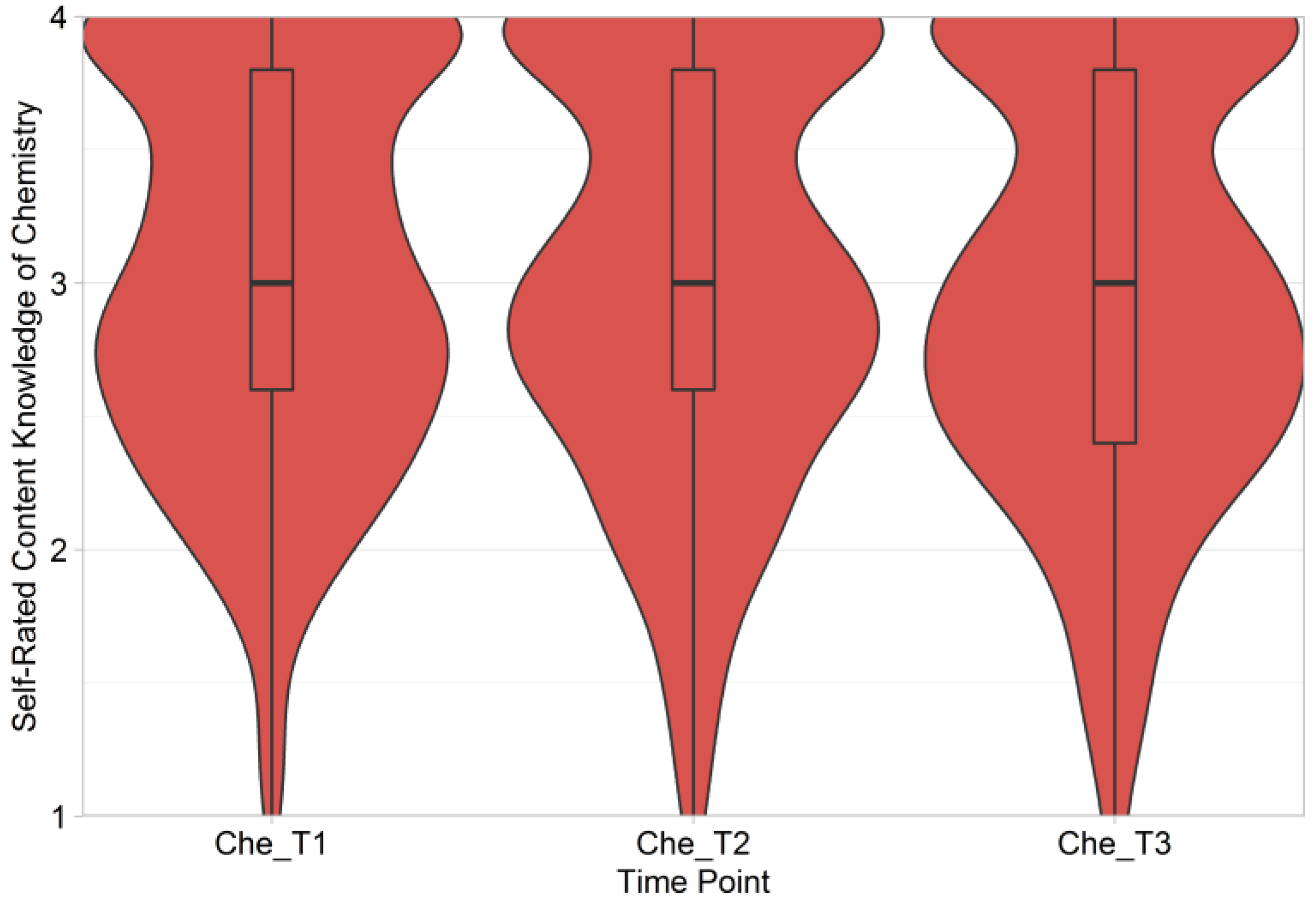
5.2.3. Self-Rated Content Knowledge of Physics

5.3. Research Question 3: Factors Influencing the Stability of Self-Rated Content Knowledge of Biology, of Chemistry, and of Physics
5.3.1. Hypothesis 2a–d: Effect of the Studied Subjects on the Self-Rated Content Knowledge of Biology, of Chemistry, and of Physics
- Study participants who studied the subject of the srCK in question showed the highest (and absolutely high) values.
- Regarding the srCK of unstudied subjects:
- Study participants who studied chemistry showed rather neutral srCK of biology and slightly positive srCK of physics.
- Study participants who studied biology showed low srCK of physics and vice versa.
- Study participants who studied biology or physics showed rather neutral srCK of chemistry.
5.3.2. Hypothesis 3: Effect of a Biology Content Knowledge Course on the Self-Rated Biology Content Knowledge of Pre-Service Chemistry and Physics Teachers
6. Discussion
- Studying the subject according to the srCK is very positive for the srCK and indicates a positive effect of discipline-specific teacher education on the intended subject.
- From the (prospective) teachers’ perspective, chemistry and physics have a rather positive relation, that could be used for teaching interdisciplinary science.
- From the (prospective) teachers’ perspective, biology and physics have a rather strong negative relation, which could be an enormous challenge for teaching interdisciplinary science.
7. Conclusions
7.1. Limitations and Future Research
7.2. Implications
- Due to the very stable values of the srCK of biology, of chemistry, and of physics during teacher education, active interventions and advanced trainings are necessary for interdisciplinary science teaching (e.g., [13]). Otherwise, the negative effect of studying physics and the intercorrelations of the srCK of biology, of chemistry, and of physics do not seem to change over time. It needs to be considered whether a voluntary offer can suffice at all.
- A focus on the relation between biology and physics is necessary to break down obvious hurdles in (prospective) teachers’ heads and/or competencies. Otherwise, biology and physics (prospective) teachers will probably struggle with the respective other unstudied subject. Perhaps the (prospective) physics teachers need even more support regarding biology CK (Figure 5: median = 1.75–1.81) than (prospective) biology teachers regarding physics CK (Figure 7: median = 2). One approach could be the integration of overlaps between the subjects in the mandatory teacher education or voluntary certificates (e.g., [13]) to highlight the relations between both subjects. In addition, it is possible to develop educational resources that especially focuses on the connection of biological and physical aspects of a topic, e.g., optics.
- The positive potential between chemistry and physics should be used in teacher education as well to facilitate interdisciplinary science teaching. The focus should not only be on the challenges for interdisciplinary science teaching, but also on the opportunities. The positive relation between chemistry and physics is one that should be used and further strengthened in teacher education, e.g., in curriculum development.
Author Contributions
Funding
 We acknowledge support by the Open Access Publication Funds of the Göttingen University (APC funding).
We acknowledge support by the Open Access Publication Funds of the Göttingen University (APC funding).Institutional Review Board Statement
Informed Consent Statement
Data Availability Statement
Acknowledgments
Conflicts of Interest
References
- Bröll, L.; Friedrich, J. Zur Qualifikation der Lehrkräfte für den NWA-Unterricht: Eine Bestandsaufnahme in Baden-Württemberg. MNU J. 2012, 65, 180–186. [Google Scholar]
- Dörges, A. Erfahrungen mit dem integrierten naturwissenschaftlichen Unterricht. MNU J. 2001, 54, 230–232. [Google Scholar]
- Fruböse, C.; Illgen, J.; Kohm, L.; Wollscheid, R. Unterricht im integrierten Fach Naturwissenschaften: Erfahrungen aus gymnasialer Sicht. MNU J. 2011, 64, 433–439. [Google Scholar]
- Handtke, K.; Bögeholz, S. Self-rated content knowledge of biology, chemistry, and physics–Developing a measure and identifying challenges for interdisciplinary science teaching. RISTAL 2020, 3, 46–67. [Google Scholar]
- Labudde, P. Fächerübergreifender naturwissenschaftlicher Unterricht—Mythen, Definitionen, Fakten. ZfDN 2014, 20, 11–19. [Google Scholar] [CrossRef]
- Neumann, K.; Härtig, H.; Harms, U.; Parchmann, I. Science Teacher Preparation in Germany. In Model Science Teacher Preparation Programs: An International Comparison of What Works; Pedersen, J.E., Isozaki, T., Hirano, T., Eds.; Information Age Publishing: Charlotte, NC, USA, 2017; pp. 29–52. [Google Scholar]
- Baumert, J.; Kunter, M. Das Kompetenzmodell von COACTIV. In Professionelle Kompetenz von Lehrkräften: Ergebnisse des Forschungsprogramms COACTIV; Kunter, M., Baumert, J., Blum, W., Klusmann, U., Krauss, S., Neubrand, M., Eds.; Waxmann: Münster, Germany, 2011; pp. 29–53. [Google Scholar]
- Zell, E.; Krizan, Z. Do People Have Insight into Their Abilities? A Metasynthesis. Perspect. Psychol. Sci. 2014, 9, 111–125. [Google Scholar] [CrossRef]
- Baumert, J.; Kunter, M. The COACTIV Model of Teachers’ Professional Competence. In Cognitive Activation in the Mathematics Classroom and Professional Competence of Teachers: Results from the COACTIV Project; Kunter, M., Baumert, J., Blum, W., Klusmann, U., Krauss, S., Neubrand, M., Eds.; Mathematics teacher education 8; Springer: New York, NY, USA, 2013; pp. 25–48. [Google Scholar]
- Forsthuber, B.; Horvath, A.; de Almeida Coutinho, A.S.; Motiejūnaitė, A.; Baïdak, N. Science Education in Europe. National Policies, Practices and Research; Education, Audiovisual and Culture Executive Agency: Brussels, Belgium, 2011. [Google Scholar]
- Niedersächsisches Kultusministerium. Kerncurriculum für die Integrierte Gesamtschule Schuljahrgänge 5–10. Naturwissenschaften; Unidruck: Hannover, Germany, 2020. [Google Scholar]
- Niedersächsisches Kultusministerium. Kerncurriculum für das Gymnasium Schuljahrgänge 5–10. Naturwissenschaften; Unidruck: Hannover, Germany, 2015. [Google Scholar]
- Eggert, S.; Bögeholz, S.; Oberle, M.; Sauer, M.; Schneider, S.; Surkamp, C. Herausforderung Interdisziplinäres Unterrichten in der Lehrerbildung: Das Göttinger Zertifikatsmodell. J. Lehr. 2018, 18, 51–55. [Google Scholar]
- Käpylä, M.; Heikkinen, J.-P.; Asunta, T. Influence of Content Knowledge on Pedagogical Content Knowledge: The case of teaching photosynthesis and plant growth. Int. J. Sci. Educ. 2009, 31, 1395–1415. [Google Scholar] [CrossRef]
- Sadler, P.M.; Sonnert, G.; Coyle, H.P.; Cook-Smith, N.; Miller, J.L. The Influence of Teachers’ Knowledge on Student Learning in Middle School Physical Science Classrooms. Am. Educ. Res. J. 2013, 50, 1020–1049. [Google Scholar] [CrossRef]
- Kleickmann, T.; Tröbst, S.; Heinze, A.; Bernholt, A.; Rink, R.; Kunter, M. Teacher Knowledge Experiment: Conditions of the Development of Pedagogical Content Knowledge. In Competence Assessment in Education: Research, Models and Instruments; Softcover reprint of the original 1st edition 2017; Leutner, D., Fleischer, J., Grünkorn, J., Klieme, E., Eds.; Methodology of Educational Measurement and Assessment; Springer International Publishing: Cham, Germany, 2018; pp. 111–129. [Google Scholar]
- Baumert, J.; Kunter, M.; Blum, W.; Brunner, M.; Voss, T.; Jordan, A.; Klusmann, U.; Krauss, S.; Neubrand, M.; Tsai, Y.-M. Teachers’ Mathematical Knowledge, Cognitive Activation in the Classroom, and Student Progress. Am. Educ. Res. J. 2010, 47, 133–180. [Google Scholar] [CrossRef]
- Oberle, M. Politisches Wissen über die Europäische Union. Subjektive und Objektive Politikkenntnisse von Jugendlichen; Springer VS: Wiesbaden, Germany, 2012. [Google Scholar]
- Shavelson, R.J.; Hubner, J.J.; Stanton, G.C. Self-Concept: Validation of Construct Interpretations. Rev. Educ. Res. 1976, 46, 407–441. [Google Scholar] [CrossRef]
- Dickhäuser, O.; Schöne, C.; Spinath, B.; Stiensmeier-Pelster, J. Die Skalen zum akademischen Selbstkonzept: Konstruktion und Überprüfung eines neuen Instrumentes. Z. Differ. Diagn. Psychol. 2002, 23, 393–405. [Google Scholar]
- Neumann, K.; Kind, V.; Harms, U. Probing the amalgam: The relationship between science teachers’ content, pedagogical and pedagogical content knowledge. Int. J. Sci. Educ. 2019, 41, 847–861. [Google Scholar] [CrossRef]
- Marsh, H.W.; Craven, R.G. Reciprocal Effects of Self-Concept and Performance from a Multidimensional Perspective. Perspect. Psychol. Sci. 2006, 1, 133–163. [Google Scholar] [CrossRef]
- Marsh, H.W.; Martin, A.J. Academic self-concept and academic achievement: Relations and causal ordering. Br. J. Educ. Psychol. 2011, 81, 59–77. [Google Scholar] [CrossRef] [PubMed]
- Paulick, I.; Großschedl, J.; Harms, U.; Möller, J. Preservice Teachers’ Professional Knowledge and Its Relation to Academic Self-Concept. J. Teach. Educ. 2016, 67, 173–182. [Google Scholar] [CrossRef]
- Sorge, S.; Keller, M.M.; Neumann, K.; Möller, J. Investigating the relationship between pre-service physics teachers’ professional knowledge, self-concept, and interest. J. Res. Sci. Teach. 2019, 56, 937–955. [Google Scholar] [CrossRef]
- Jansen, M.; Schroeders, U.; Lüdtke, O.; Pant, H.A. Interdisziplinäre Beschulung und die Struktur des akademischen Selbstkonzepts in den naturwissenschaftlichen Fächern. Z. Pädagog. Psychol. 2014, 28, 43–49. [Google Scholar] [CrossRef]
- Hardy, G. Academic Self-Concept: Modeling and Measuring for Science. Res. Sci. Educ. 2014, 44, 549–579. [Google Scholar] [CrossRef]
- Yilmaz-Tuzun, O. Preservice Elementary Teachers’ Beliefs about Science Teaching. J. Sci. Teach. Educ. 2008, 19, 183–204. [Google Scholar] [CrossRef]
- Yangin, S.; Sidekli, S. Self-Efficacy for Science Teaching Scale Development: Construct Validation with Elementary School Teachers. J. Educ. Train. Stud. 2016, 4, 54–69. [Google Scholar] [CrossRef]
- Nixon, R.S.; Hill, K.M.; Luft, J.A. Secondary Science Teachers’ Subject Matter Knowledge Development across the First 5 Years. J. Sci. Teach. Educ. 2017, 28, 574–589. [Google Scholar] [CrossRef]
- Sorge, S.; Keller, M.; Petersen, S.; Neumann, K. Die Entwicklung des Professionswissen angehender Physiklehrkräfte. In Qualitätsvoller Chemie- und Physikunterricht—Normative und Empirische Dimensionen; Maurer, C., Ed.; Gesellschaft für Didaktik der Chemie und Physik, Jahrestagung in Regensburg 2017; Universität Regensburg: Regensburg, Germany, 2018; pp. 114–117. [Google Scholar]
- Arzi, H.J.; White, R.T. Change in Teachers’ Knowledge of Subject Matter: A 17-Year Longitudinal Study. Sci. Ed. 2008, 92, 221–251. [Google Scholar] [CrossRef]
- Beudels, M.M.; Damerau, K.; Preisfeld, A. Effects of an Interdisciplinary Course on Pre-Service Primary Teachers’ Content Knowledge and Academic Self-Concepts in Science and Technology: A Quantitative Longitudinal Study. Educ. Sci. 2021, 11, 744. [Google Scholar] [CrossRef]
- Peschel, M. SelfPro: Entwicklung von Professionsverständnissen und Selbstkonzepten angehender Lehrkräfte beim Offenen Experimentieren. In Profession und Disziplin: Grundschulpädagogik im Diskurs; Miller, S., Holler-Nowitzki, B., Kottmann, B., Lesemann, S., Letmathe-Henkel, B., Meyer, N., Schroeder, R., Velten, K., Eds.; Jahrbuch Grundschulforschung Band 22; Springer VS: Wiesbaden, Germany, 2018; pp. 191–196. [Google Scholar]
- Newsom, J.T. Longitudinal Structural Equation Modeling. A Comprehensive Introduction; Routledge Taylor and Francis Group: New York, NY, USA, 2015. [Google Scholar]
- Handtke, K.; Bögeholz, S. Arguments for Construct Validity of the Self-Efficacy Beliefs of Interdisciplinary Science Teaching (SElf-ST) Instrument. Eur. J. Educ. Res. 2020, 9, 1435–1453. [Google Scholar] [CrossRef]
- Handtke, K. Entwicklung von Messinstrumenten für Selbstwirksamkeitserwartungen und selbstberichtetes Fachwissen zum Unterrichten von Naturwissenschaften. Ph.D. Thesis, Georg-August-Universität Göttingen, Göttingen, Germany, 2021. [Google Scholar]
- Statistisches Bundesamt (Destatis). Bildung und Kultur. Studierende an Hochschulen. Wintersemester 2018/2019. Available online: https://www.destatis.de/DE/Themen/Gesellschaft-Umwelt/Bildung-Forschung-Kultur/Hochschulen/Publikationen/Downloads-Hochschulen/studierende-hochschulen-endg-2110410197004.pdf;jsessionid=2668C17F0FB411994FB9829152E97351.internet8711?__blob=publicationFile (accessed on 10 November 2022).
- Handtke, K.; Bögeholz, S. Self-Efficacy Beliefs of Interdisciplinary Science Teaching (SElf-ST) Instrument: Drafting a Theory-based Measurement. Educ. Sci. 2019, 9, 247. [Google Scholar] [CrossRef]
- Putnick, D.L.; Bornstein, M.H. Measurement Invariance Conventions and Reporting: The State of the Art and Future Directions for Psychological Research. Dev. Rev. 2016, 41, 71–90. [Google Scholar] [CrossRef]
- Little, T.D. Longitudinal Structural Equation Modeling; The Guilford Press: New York, NY, USA, 2013. [Google Scholar]
- Wheaton, B.; Muthén, B.; Alwin, D.F.; Summers, G.F. Assessing Reliability and Stability in Panel Models. Sociol. Methodol. 1977, 8, 84–136. [Google Scholar] [CrossRef]
- Chen, F.F. Sensitivity of Goodness of Fit Indexes to Lack of Measurement Invariance. Struct. Equ. Model. 2007, 14, 464–504. [Google Scholar] [CrossRef]
- Akaike, H. Information theory as an extension of the maximum likelihood principle. In Second International Symposium on Information Theory; Petrov, B.N., Csaki, F., Eds.; Akademiai Kiado: Budapest, Hungary, 1973; pp. 267–281. [Google Scholar]
- Schwarz, G. Estimating the Dimension of a Model. Ann. Statist. 1978, 6, 461–464. [Google Scholar] [CrossRef]
- Urban, D.; Mayerl, J. Strukturgleichungsmodellierung. Ein Ratgeber für die Praxis; Springer VS: Wiesbaden, Germany, 2014. [Google Scholar]
- Vandenberg, R.J.; Lance, C.E. A Review and Synthesis of the Measurement Invariance Literature: Suggestions, Practices, and Recommendations for Organizational Research. Organ. Res. Methods 2000, 3, 4–70. [Google Scholar] [CrossRef]
- Rosseel, Y.; Jorgensen, T.D.; Rockwood, N.; Oberski, D.; Byrnes, J.; Vanbrabant, L.; Savalei, V.; Merkle, E.; Hallquist, M.; Rhemtulla, M.; et al. Lavaan: Latent Variable Analysis. Available online: https://cran.r-project.org/web/packages/lavaan/lavaan.pdf (accessed on 27 August 2020).
- Wickham, H.; Chang, W.; Henry, L.; Pedersen, T.L.; Takahashi, K.; Wilke, C.; Woo, K.; Yutani, H.; Dunnington, D.; RStudio. ggplot2: Create Elegant Data Visualisations Using the Grammar of Graphics. Available online: https://cran.r-project.org/web/packages/ggplot2/ggplot2.pdf (accessed on 1 July 2021).
- Wickham, H.; Girlich, M.; RStudio. tidyr: Tidy Messy Data. Available online: https://cran.r-project.org/web/packages/tidyr/tidyr.pdf (accessed on 2 February 2022).
- Christ, O.; Schlüter, E. Strukturgleichungsmodelle mit Mplus. Eine Praktische Einführung; Oldenbourg: München, Germany, 2012. [Google Scholar]
- Muthén, L.K.; Muthén, B.O. Mplus User’s Guide; Muthén & Muthén: Los Angeles, CA, USA, 2017. [Google Scholar]
- Geiser, C. Datenanalyse mit Mplus. Eine Anwendungsorientierte Einführung; VS Verlag für Sozialwissenschaften: Wiesbaden, Germany, 2010. [Google Scholar]
- Steyer, R.; Eid, M.; Schwenkmezger, P. Modeling True Intraindividual Change: True Change as a Latent Variable. Methods Psychol. Res. Online 1997, 2, 21–33. [Google Scholar]
- Steyer, R.; Partchev, I.; Shanahan, M.J. Modeling True Intraindividual Change in Structural Equation Models: The Case of Poverty and Children’s Psychosocial Adjustment. In Modeling Longitudinal and Multilevel Data: Practical Issues, Applied Approaches, and Specific Examples; Little, T.D., Schnabel, K.U., Baumert, J., Eds.; Erlbaum: Mahwah, NJ, USA, 2000; pp. 109–126. [Google Scholar]
- McArdle, J.J. Dynamic but structural equation modeling of repeated measures dara. In Handbook of Multivariate Experimental Psychology; Cattell, R.B., Nesselroade, J., Eds.; Plenum Press: New York, NY, USA, 1988; pp. 561–614. [Google Scholar]
- McArdle, J.J.; Hamagami, F. Latent difference score structural models for linear dynamic analysis with incomplete longitudinal data. In New Methods for the Analysis of Change; Collins, L.M., Sayer, A.G., Eds.; American Psychological Association: Washington, DC, USA, 2001; pp. 137–175. [Google Scholar]
- Cohen, J.; Cohen, P.; West, S.G.; Aiken, L.S. Applied Multiple Regression/Correlation Analysis for the Behavioral Sciences, 3rd ed.; Lawrence Erlbaum Associates: Mahwah, NJ, USA, 2003. [Google Scholar]
- Cohen, J. Statistical Power Analysis for the Behavioral Sciences; Erlbaum: Hillsdale, NJ, USA, 1988. [Google Scholar]
- Leonhart, R. Lehrbuch Statistik. Einstieg und Vertiefung, 3rd ed.; Hans Huber: Bern, Switzerland, 2013. [Google Scholar]
- White, S.; Tyler, J. High School Physics Teacher Preparation: Results from the 2012–13 Nationwide Survey of High School Physics Teachers. Available online: https://www.aip.org/sites/default/files/statistics/highschool/hs-teacherprep-12.pdf (accessed on 2 December 2016).
- Busch, M.; Woest, V. Fächerübergreifender naturwissenschaftlicher Unterricht: Empirische Befunde zu Potenzial und Grenzen aus Lehrerperspektive. MNU J. 2016, 69, 269–277. [Google Scholar]
- Handtke, K.; Richter-Beuschel, L.; Bögeholz, S. Self-Efficacy Beliefs of Teaching ESD: A Theory-Driven Instrument and the Effectiveness of ESD in German Teacher Education. Sustainability 2022, 14, 6477. [Google Scholar] [CrossRef]
- Handtke, K. Die Zukunft der Lehrkräfteausbildung?: Was Biologie-Lehramtsstudierende über das fächerübergreifende Unterrichten von Naturwissenschaften denken. BiuZ 2022, 52, 320–322. [Google Scholar]
- Kelley, T.R.; Knowles, J.G.; Holland, J.D.; Han, J. Increasing High School Teachers Self-Efficacy for Integrated STEM Instruction through a Collaborative Community of Practice. Int. J. STEM Educ. 2020, 7, 14. [Google Scholar] [CrossRef]
- Aguilera, D.; Ortiz-Revilla, J. STEM vs. STEAM Education and Student Creativity: A Systematic Literature Review. Educ. Sci. 2021, 11, 331. [Google Scholar] [CrossRef]
- Burrows, A.; Lockwood, M.; Borowczak, M.; Janak, E.; Barber, B. Integrated STEM: Focus on Informal Education and Community Collaboration through Engineering. Educ. Sci. 2018, 8, 4. [Google Scholar] [CrossRef]
- Sanders, M. STEM, STEM Education, STEMmania. Technol. Teach. 2009, 68, 20–26. [Google Scholar]

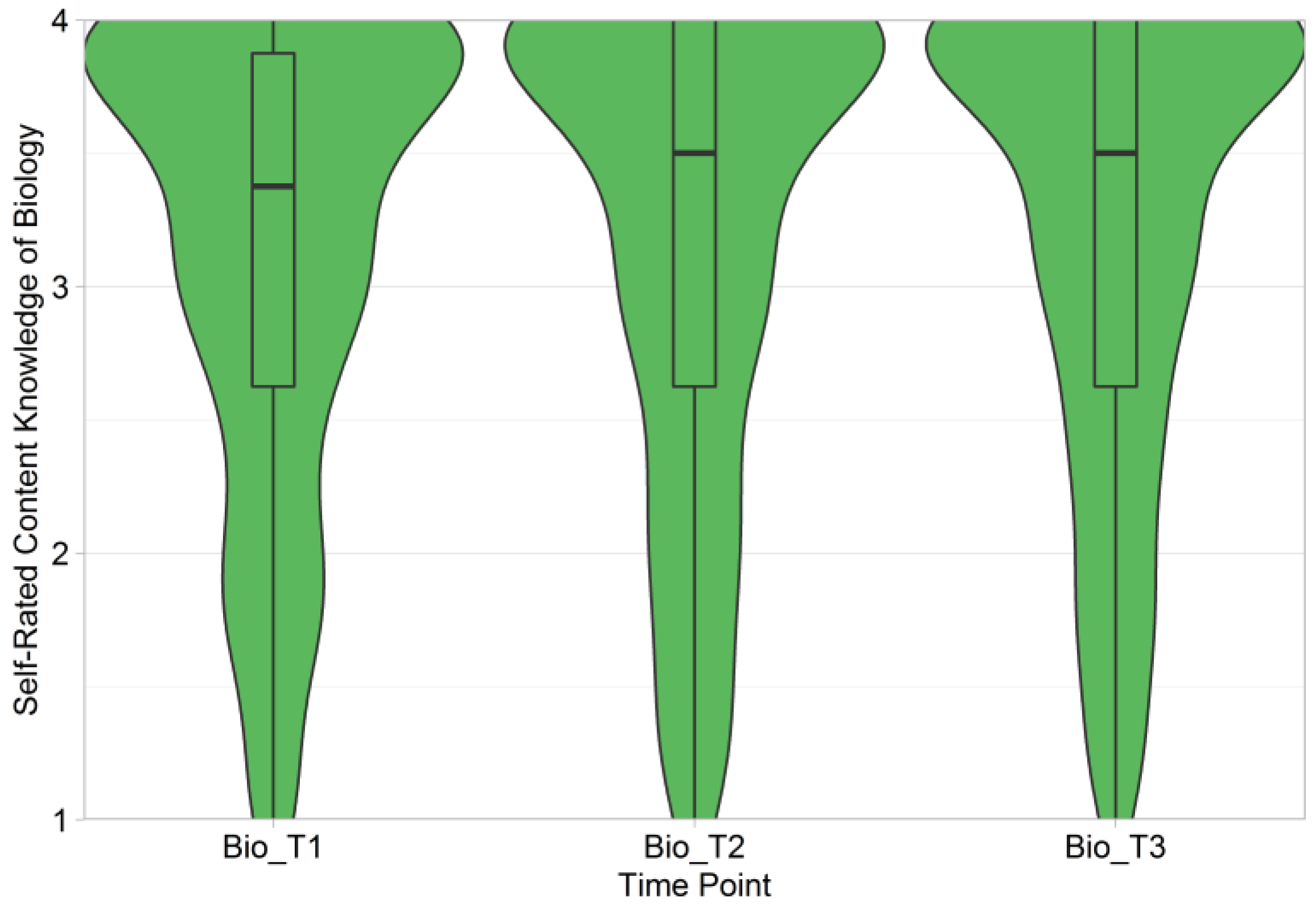

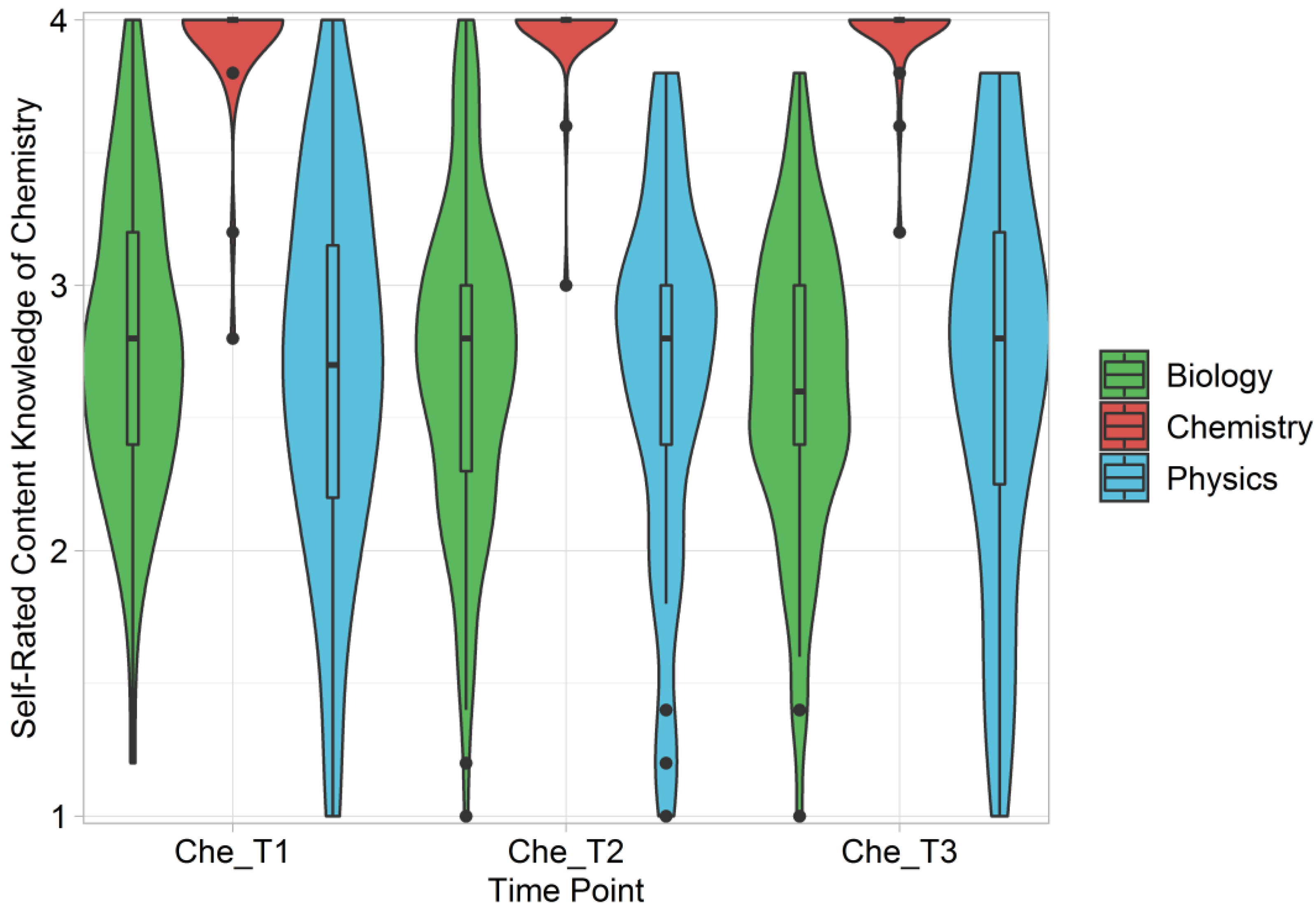
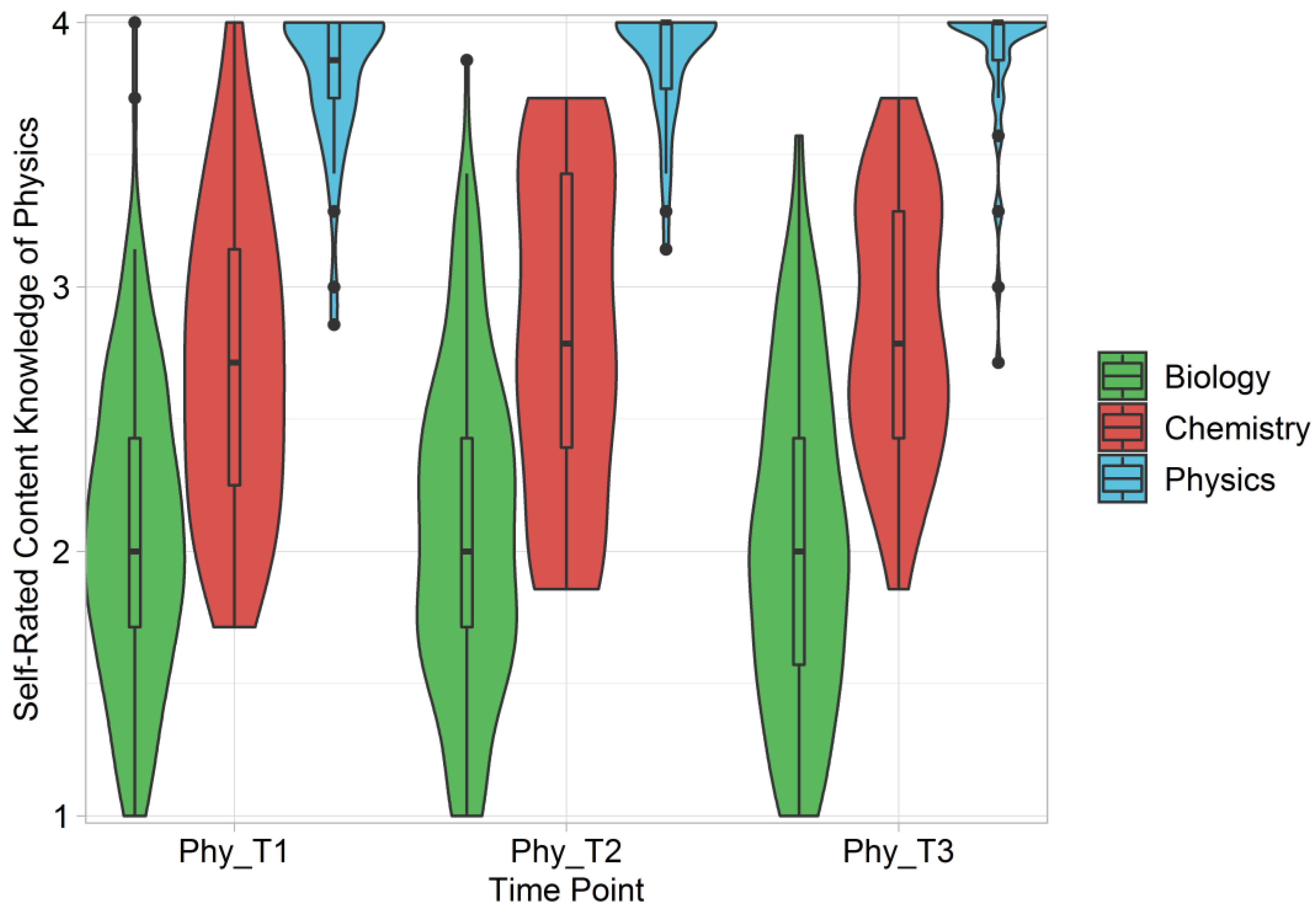
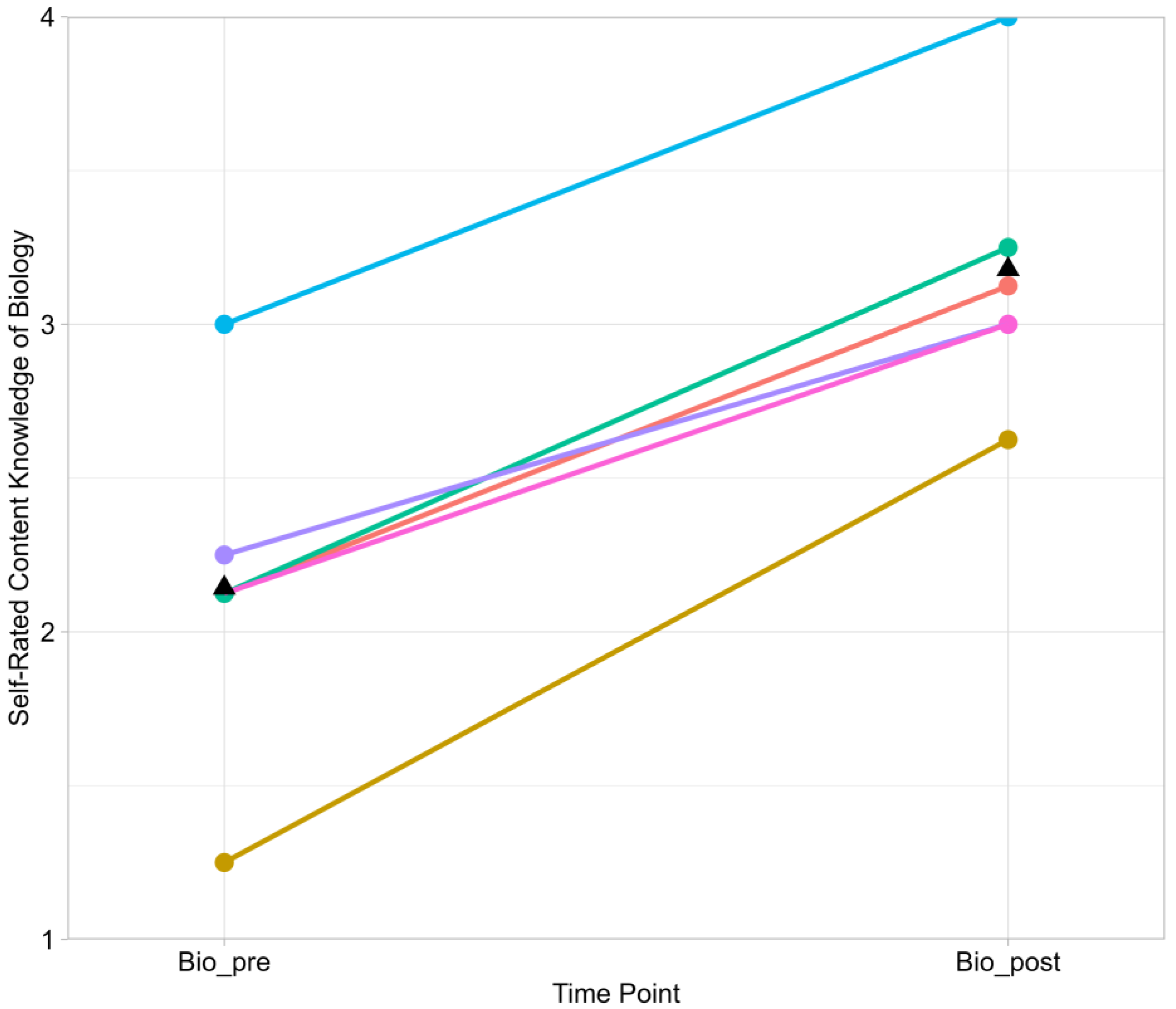
| Time Point 1 (2019) | Time Point 2 (2020) | Time Point 3 (2021) | |
|---|---|---|---|
| Sex | |||
| Female | 62.73% | 63.10% | 62.73% |
| Male | 36.90% | 36.16% | 36.53% |
| Subjects studied | |||
| Biology | 54.24% | 53.51% | 53.51% |
| Chemistry | 13.28% | 13.28% | 13.28% |
| Physics | 15.50% | 15.50% | 15.50% |
| Biology and chemistry | 12.20% | 12.55% | 12.55% |
| Biology and physics | 2.21% | 2.21% | 2.21% |
| Chemistry and physics | 2.21% | 2.21% | 2.21% |
| Biology, chemistry, and physics | 0.37% | 0.74% | 0.74% |
| Phase of teacher education | |||
| Bachelor | 62.36% | 44.28% | 20.30% |
| Master of Education | 36.16% | 48.00% | 57.93% |
| Trainee teacher | 1.48% | 7.01% | 18.08% |
| In-service teacher | 0.00% | 0.74% | 3.69% |
| Configural | Metric | |
|---|---|---|
| X2/df (p-value) | 2596.76/1614 (<0.001) | 2634.07/1648 (<0.001) |
| X2 Difference/df (p-value) | - | 33.74/34 (0.480) |
| Rob. CFI (∆CFI) | 0.946 (-) | 0.946 (-) |
| AIC | 27,270.08 | 27,231.09 |
| BIC | 28,048.14 | 27,886.68 |
| Adj. BIC | 27,363.27 | 27,309.61 |
| Rob. RMSEA (∆RMSEA) | 0.048 (-) | 0.048 (-) |
| Configural | Metric | Scalar | Residual | |
|---|---|---|---|---|
| X2/df (p-value) | 405.67/225 (<0.001) | 423.51/239 (<0.001) | 448.13/253 (<0.001) | 465.47/269 (<0.001) |
| X2 Difference/df (p-value) | - | 15.42/14 (0.350) | 24.56/14 (0.039) | 19.97/16 (0.222) |
| Rob. CFI (∆CFI) | 0.972 (-) | 0.972 (-) | 0.971 (−0.001) | 0.970 (−0.001) |
| AIC | 9987.04 | 9973.97 | 9970.30 | 9972.29 |
| BIC | 10,343.65 | 10,280.15 | 10,226.05 | 10,170.40 |
| Adj. BIC | 10,029.75 | 10,010.64 | 10,000.93 | 9996.01 |
| Rob. RMSEA (∆RMSEA) | 0.062 (-) | 0.061 (−0.001) | 0.060 (−0.001) | 0.059 (−0.001) |
| Configural | Metric | Scalar | Residual | |
|---|---|---|---|---|
| X2/df (p-value) | 118.46/72 (<0.001) | 128.10/80 (0.001) | 139.46/88 (<0.001) | 154.17/98 (<0.001) |
| X2 Difference/df (p-value) | - | 8.18/8 (0.416) | 11.00/8 (0.202) | 14.67/10 (0.145) |
| Rob. CFI (∆CFI) | 0.984 (-) | 0.984 (-) | 0.983 (−0.001) | 0.982 (−0.001) |
| AIC | 6632.09 | 6623.39 | 6618.34 | 6615.63 |
| BIC | 6859.020 | 6821.50 | 6787.64 | 6748.91 |
| Adj. BIC | 6659.27 | 6647.11 | 6638.62 | 6631.60 |
| Rob. RMSEA (∆RMSEA) | 0.056 (-) | 0.053 (−0.003) | 0.052 (−0.001) | 0.051 (−0.001) |
| Configural | Metric | Scalar | Residual | |
|---|---|---|---|---|
| X2/df (p-value) | 312.04/165 (<0.001) | 326.80/177 (<0.001) | 345.19/189 (<0.001) | 373.16/203 (<0.001) |
| X2 Difference/df (p-value) | - | 9.92/12 (0.623) | 17.89/12 (0.119) | 28.24/14 (0.013) |
| Rob. CFI (∆CFI) | 0.970 (-) | 0.971 (+0.001) | 0.970 (−0.001) | 0.967 (−0.003) |
| AIC | 10,966.67 | 10,949.67 | 10,943.45 | 10,943.83 |
| BIC | 11,280.05 | 11,219.83 | 11,170.38 | 11,120.33 |
| Adj. BIC | 11,004.20 | 10,982.03 | 10,970.62 | 10,964.97 |
| Rob. RMSEA (∆RMSEA) | 0.062 (-) | 0.060 (−0.002) | 0.059 (−0.001) | 0.059 (-) |
| Bio1 | Che1 | Phy1 | Bio2 | Che2 | Phy2 | Bio3 | Che3 | Phy3 | |
|---|---|---|---|---|---|---|---|---|---|
| Bio1 | 1.00 | - | - | - | - | - | - | - | - |
| Che1 | 0.03 | 1.00 | - | - | - | - | - | - | - |
| Phy1 | −0.52 ** | 0.23 ** | 1.00 | - | - | - | - | - | - |
| Bio2 | 0.89 ** | −0.01 | −0.59 ** | 1.00 | - | - | - | - | - |
| Che2 | −0.05 | 0.85 ** | 0.15 * | 0.03 | 1.00 | - | - | - | - |
| Phy2 | −0.54 ** | 0.18 * | 0.90 ** | −0.56 ** | 0.23 ** | 1.00 | - | - | - |
| Bio3 | 0.89 ** | −0.05 | −0.59 ** | 0.92 ** | −0.06 | −0.58 ** | 1.00 | - | - |
| Che3 | −0.10 | 0.83 ** | 0.21 ** | −0.07 | 0.89 ** | 0.27 ** | −0.08 | 1.00 | - |
| Phy3 | −0.52 ** | 0.23 ** | 0.89 ** | −0.57 ** | 0.23 ** | 0.93 ** | −0.57 ** | 0.30 ** | 1.00 |
| Studied Subject | srCK of biology | srCK of chemistry | srCK of physics | |||
|---|---|---|---|---|---|---|
| β (SE) | p | β (SE) | p | β (SE) | p | |
| Biology | 0.78 (0.05) | <0.001 | −0.07 (0.07) | 0.340 | −0.07 (0.06) | 0.205 |
| Chemistry | 0.04 (0.04) | 0.291 | 0.67 (0.05) | <0.001 | 0.21 (0.04) | <0.001 |
| Physics | −0.13 (0.06) | 0.021 | −0.08 (0.08) | 0.309 | 0.80 (0.04) | <0.001 |
| srCK of biology | srCK of chemistry | srCK of physics | |
|---|---|---|---|
| Starting value T1 | 0.73 | 0.50 | 0.71 |
| Change T1–T2 | 0.03 | 0.03 | 0.01 |
| Change T2–T3 | 0.01 | 0.03 | 0.01 |
Publisher’s Note: MDPI stays neutral with regard to jurisdictional claims in published maps and institutional affiliations. |
© 2022 by the authors. Licensee MDPI, Basel, Switzerland. This article is an open access article distributed under the terms and conditions of the Creative Commons Attribution (CC BY) license (https://creativecommons.org/licenses/by/4.0/).
Share and Cite
Handtke, K.; Bögeholz, S. The Challenge to Link Biology, Chemistry, and Physics: Results of a Longitudinal Study on Self-Rated Content Knowledge. Educ. Sci. 2022, 12, 928. https://doi.org/10.3390/educsci12120928
Handtke K, Bögeholz S. The Challenge to Link Biology, Chemistry, and Physics: Results of a Longitudinal Study on Self-Rated Content Knowledge. Education Sciences. 2022; 12(12):928. https://doi.org/10.3390/educsci12120928
Chicago/Turabian StyleHandtke, Kevin, and Susanne Bögeholz. 2022. "The Challenge to Link Biology, Chemistry, and Physics: Results of a Longitudinal Study on Self-Rated Content Knowledge" Education Sciences 12, no. 12: 928. https://doi.org/10.3390/educsci12120928
APA StyleHandtke, K., & Bögeholz, S. (2022). The Challenge to Link Biology, Chemistry, and Physics: Results of a Longitudinal Study on Self-Rated Content Knowledge. Education Sciences, 12(12), 928. https://doi.org/10.3390/educsci12120928





